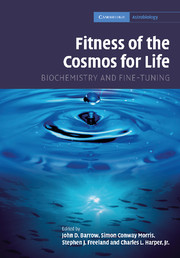Book contents
- Frontmatter
- Contents
- List of contributors
- Foreword: The improbability of life
- Preface
- Acknowledgments
- Part I The fitness of “fitness”: Henderson in context
- 1 Locating “fitness” and L. J. Henderson
- 2 Revisiting The Fitness of the Environment
- 3 Is fine-tuning remarkable?
- 4 Complexity in context: the metaphysical implications of evolutionary theory
- 5 Tuning fine-tuning
- Part II The fitness of the cosmic environment
- Part III The fitness of the terrestrial environment
- Part IV The fitness of the chemical environment
- Index
- References
5 - Tuning fine-tuning
Published online by Cambridge University Press: 18 December 2009
- Frontmatter
- Contents
- List of contributors
- Foreword: The improbability of life
- Preface
- Acknowledgments
- Part I The fitness of “fitness”: Henderson in context
- 1 Locating “fitness” and L. J. Henderson
- 2 Revisiting The Fitness of the Environment
- 3 Is fine-tuning remarkable?
- 4 Complexity in context: the metaphysical implications of evolutionary theory
- 5 Tuning fine-tuning
- Part II The fitness of the cosmic environment
- Part III The fitness of the terrestrial environment
- Part IV The fitness of the chemical environment
- Index
- References
Summary
The chapters in this volume, written from a wide variety of perspectives, explore the possibility of extending the theme of “fine-tuning” beyond the domain of cosmology, where it first entered into serious discussion in the mid-1970s, to other sciences such as biochemistry and biology. As a prelude to this investigation, it seems worthwhile to explore the theme of fine-tuning itself in some detail, given the ambiguities that still surround it and the vigor of the continuing disagreement as to what its implications are. How did fine-tuning make its way into the cosmological discussion? What precisely did – and does – it amount to? What were – and still are – the responses to it? How is one to evaluate those responses? Achieving a measure of clarity on these issues should make it easier to appreciate the search for fine-tuning or its analogs elsewhere in the sciences.
The infinities of space and time in Newtonian mechanics were not propitious to the formulation of a cosmology, a theory of the cosmic whole, although the notion of gravity gave a hint, at least, as to how material complexity could form. The unification of space and time by Einstein's general theory in a non-Euclidean geometrical framework offered new possibilities, and Hubble's subsequent confirmation of galactic expansion pointed Lemaître to a universe model that would, from a “primeval atom,” expand into the universe we know.
- Type
- Chapter
- Information
- Fitness of the Cosmos for LifeBiochemistry and Fine-Tuning, pp. 70 - 94Publisher: Cambridge University PressPrint publication year: 2007
References
- 2
- Cited by



